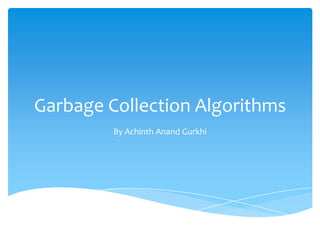Garbage collection algorithms
•Télécharger en tant que PPTX, PDF•
12 j'aime•11,463 vues
Presentation about various algorithms used for automatic garbage collection.
Signaler
Partager
Signaler
Partager

Recommandé
Recommandé
Contenu connexe
Tendances
Tendances (20)
Similaire à Garbage collection algorithms
Similaire à Garbage collection algorithms (20)
Memory Management in the Java Virtual Machine(Garbage collection)

Memory Management in the Java Virtual Machine(Garbage collection)
An introduction to G1 collector for busy developers

An introduction to G1 collector for busy developers
Memory Management in Go: Stack, Heap & Garbage Collector

Memory Management in Go: Stack, Heap & Garbage Collector
Dernier
Dernier (20)
Why Teams call analytics are critical to your entire business

Why Teams call analytics are critical to your entire business
Apidays New York 2024 - Scaling API-first by Ian Reasor and Radu Cotescu, Adobe

Apidays New York 2024 - Scaling API-first by Ian Reasor and Radu Cotescu, Adobe
Strategize a Smooth Tenant-to-tenant Migration and Copilot Takeoff

Strategize a Smooth Tenant-to-tenant Migration and Copilot Takeoff
Strategies for Landing an Oracle DBA Job as a Fresher

Strategies for Landing an Oracle DBA Job as a Fresher
Cloud Frontiers: A Deep Dive into Serverless Spatial Data and FME

Cloud Frontiers: A Deep Dive into Serverless Spatial Data and FME
DEV meet-up UiPath Document Understanding May 7 2024 Amsterdam

DEV meet-up UiPath Document Understanding May 7 2024 Amsterdam
Polkadot JAM Slides - Token2049 - By Dr. Gavin Wood

Polkadot JAM Slides - Token2049 - By Dr. Gavin Wood
Boost Fertility New Invention Ups Success Rates.pdf

Boost Fertility New Invention Ups Success Rates.pdf
Six Myths about Ontologies: The Basics of Formal Ontology

Six Myths about Ontologies: The Basics of Formal Ontology
Connector Corner: Accelerate revenue generation using UiPath API-centric busi...

Connector Corner: Accelerate revenue generation using UiPath API-centric busi...
Apidays New York 2024 - The value of a flexible API Management solution for O...

Apidays New York 2024 - The value of a flexible API Management solution for O...
Vector Search -An Introduction in Oracle Database 23ai.pptx

Vector Search -An Introduction in Oracle Database 23ai.pptx
Garbage collection algorithms
- 1. Garbage Collection Algorithms By Achinth Anand Gurkhi
- 2. What is Garbage Collection? Garbage Collection is the process by which unused objects are deleted to reclaim memory space Invented by John McCarthy around 1959 to solve problems in Lisp It is used in Lisp, Smalltalk, Eiffel, Haskell, ML, Schema, Modula-3, Java and .NET
- 3. GC Algorithms Reference Counting Mark-Sweep Collector Copying Collector Mark-Compact Collector Generational Collector
- 4. Reference Counting Needs help from compiler and the program to maintain a reference count Compiler adds code to increment/decrement reference count when the object is referenced/dereferenced If reference count is zero it is garbage collected and reference count of all objects it references is decremented by one Used by ANSI C++ library classes like string
- 5. Reference Counting Advantages: Garbage collection can be immediate Disadvantages: Cannot handle cyclic references Need extra memory for the reference counter Incrementing and decrementing reference counts every time a reference is created or destroyed can significantly impede performance. Example: array processing
- 6. Mark-Sweep Collector All application threads are stopped Mark: from the roots (objects referenced directly) every referenced object is visited and marked Sweep: entire heap is scanned and all unmarked objects are collected. Next all marked objects are reset
- 7. Mark-Sweep Collector Advantages: Can handle cyclic references No burden on the compiler or the application Disadvantages As entire heap is scanned, pauses would be longer If heap is paged can have performance issues Causes heap fragmentation which could lead of out of memory errors
- 8. Copying Collector The heap is divided into two equal spaces One contains active data and the other is inactive When the active half gets full, the world is stopped, live objects are moved to the inactive half and then the active half is cleared For the next cycle, roles are reversed, the inactive half becomes the active half
- 9. Copying Collector Advantages: Only live objects are visited, garbage objects are not visited Data compaction is achieved which reduces cost of object allocation and out of memory errors Disadvantages: Requires twice the heap size than other collectors Overhead of copying objects from one space to another Overhead of adjusting all references to the new copy Long lived objects are copied back and forth on every collection
- 10. Mark-Compact Collector All application threads are stopped Mark: from the roots (objects referenced directly) every referenced object is visited and marked Compact: entire heap is scanned and all unmarked objects are collected. Next all marked objects compacted at the bottom of the heap and then the flags are reset
- 11. Mark-Compact Collector Advantages: Compaction is achieved Without the hassle of long lived objects being copied back and forth Without the need for double the heap size Disadvantages Overhead of copying objects (for compaction) Overhead of adjusting all references to the new copy
- 12. Generational Collector 98% of the objects die young Copying Collectors perform well with short-lived objects Mark-Compact Collectors perform well with long-lived objects Can we use different GC algorithms based on object’s age?
- 13. Generational Collector The heap is divided into generations (usually 2 or 3) Objects are created in the young generation (gen 0) When memory is needed, a GC of gen 0 is performed & live objects are moved to the next generation (gen 1) & dead objects are collected (Copying Collector). If enough memory is now available GC is stopped Else the next older generation (gen 1) is collected. This goes on till enough memory is released or till the last (oldest) generation is reached. The last generation (old objects) uses Mark-Compact Collector algorithm
- 14. Generational Collector Advantages: GC cycles are small as all objects are not collected Only old objects are copied from one generation to another Entire heap is not scanned Disadvantages Overhead of copying objects (for compaction) Overhead of adjusting all references to the new copy